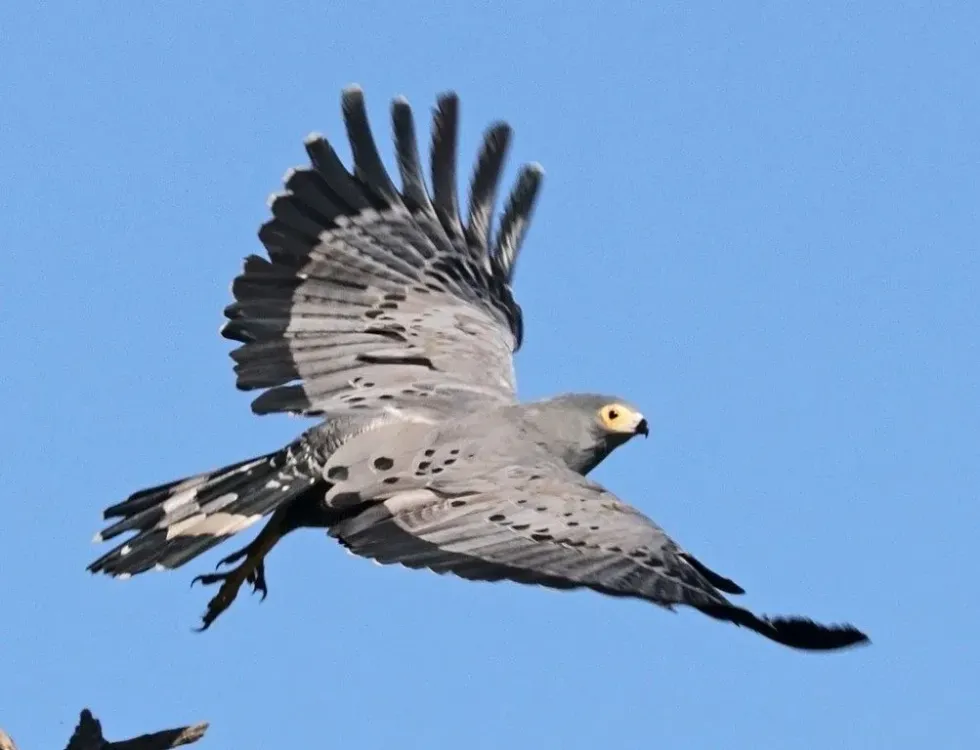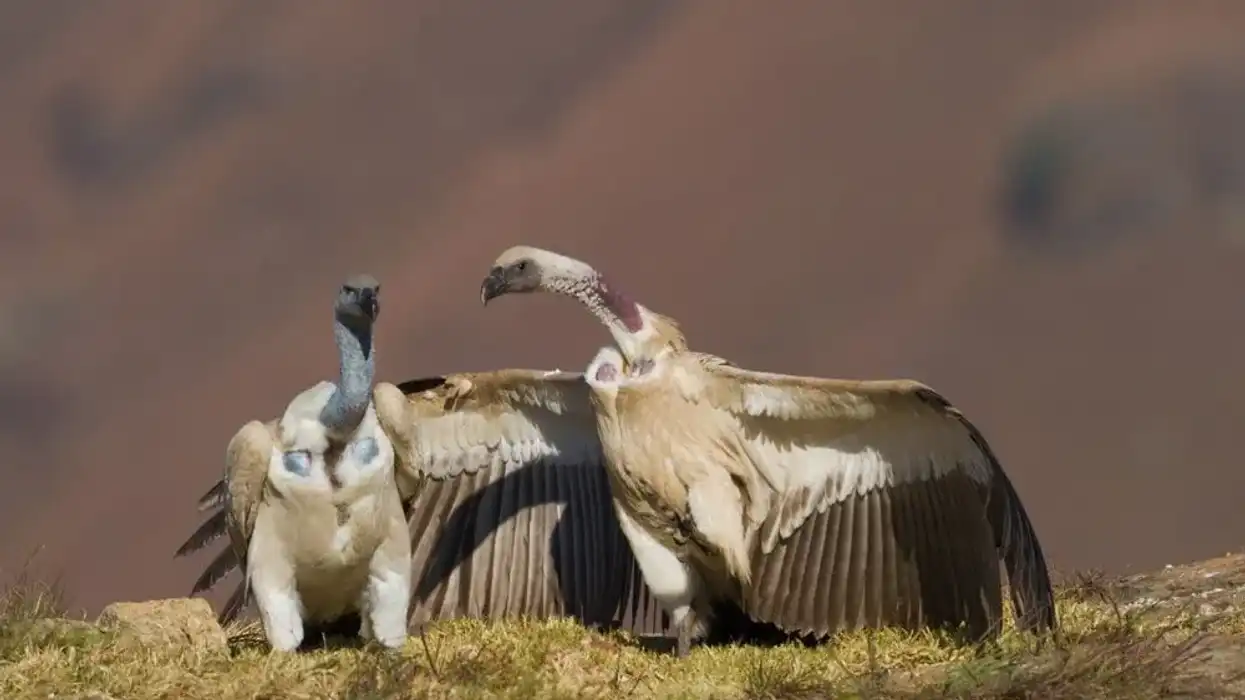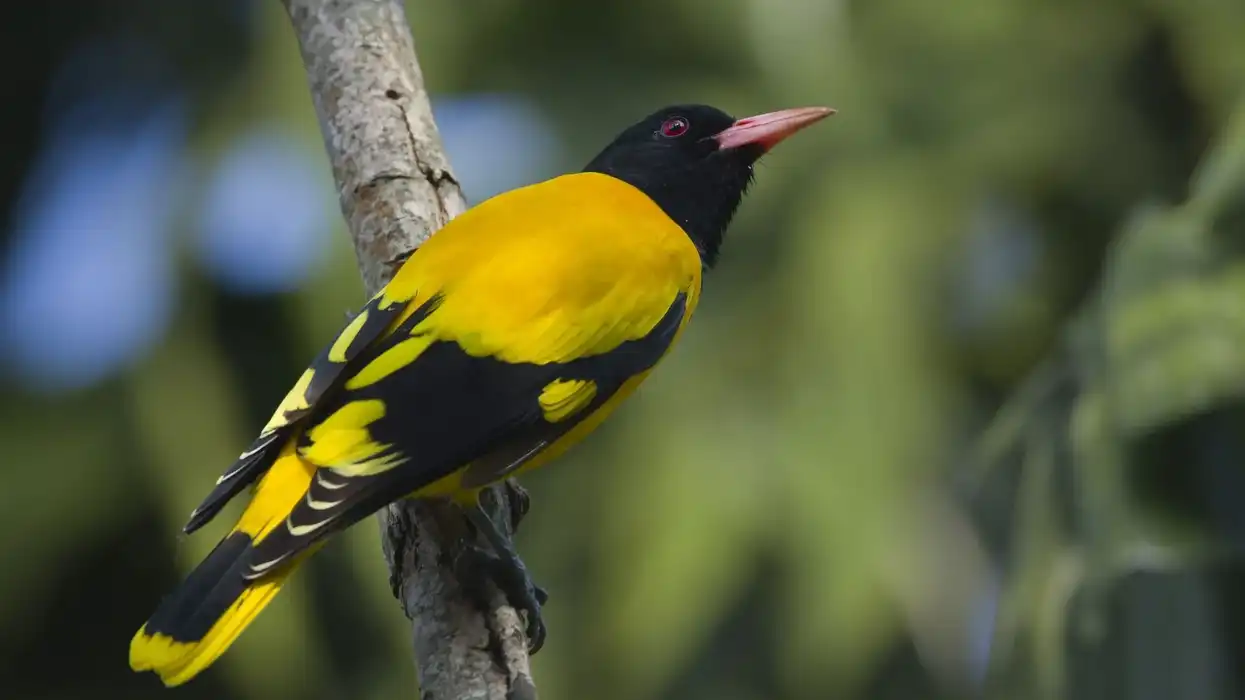The African harrier hawk (Polyboroides typus) belongs to phylum Chordata, class Aves, order Accipitiformes, and family Accipitridae. They are also known as 'gymnogene' which means 'bare cheeks'.
They are also closely related to eagles and kites and have two species, the Madagascan harrier hawk and the African harrier hawk. They are large birds with a grayish naked-faced hawk with a broad white band or white line on the tail, gray upper parts, and pale skin.
The juvenile of this bird is brown with yellow-green skin. They are specialized in flying very slowly near the ground so that they can look for prey.
They use many hunting skills like climbing the branches of trees, hanging upside down for a long time, and soaring near the hillsides to scan for African harrier-hawk prey. This hawk may look big, but it is not as powerful as other big birds.
They usually settle down for small prey like insects, lizards, and rodents. Also, sometimes, they have been seen eating fruits of oil palm.
They are widespread in the regions of tropical western Africa. They are usually seen on top of tall trees, in the forests, savannah, or woodlands in Africa.
Have an interest in birds and want to know about more of them? Here you can know some amazing facts about the Hawaiian hawk and Cooper's hawk.
African Harrier Hawk Interesting Facts
What type of animal is an African harrier hawk?
The African harrier hawk (Polyboroides typus), found only in Africa, is a medium-sized hawk and has a distinctive feature of double-jointed knees.
What class of animal does an African harrier hawk belong to?
This gray species belongs to the Aves class, family Accipitridae, and genus Polyboroides. They resemble the eastern chanting goshawk but are slightly larger in size.
How many African harrier hawks are there in the world?
The African harrier hawk population numbers are not known yet. Their population trend is stable but and has not touched the thresholds of a Vulnerable species in the IUCN Red List. You can commonly see them in western African countries.
Where does an African harrier hawk live?
This species of birds prefer to live in arid and semi-arid regions. They settle into a particular habitat. and they do not migrate or move to other regions of the world to make nests. They have an abundant population in the African countries of Zambia, Namibia, northern Sahara Desert, Zimbabwe, Mozambique, South Africa, and east of Natal,
What is an African harrier hawk's habitat?
This bird visits a variety of landscapes in central and southern Africa such as forests, woodlands, savannah, thick rainforest, riparian areas, scrublands, and tree plantations. They like to sit and look for prey very precisely by sitting on top of a tall tree.
They can also be found in the hilly countryside along deep ravines and steep hillsides in the world. This species is very adaptable and can live in urban settlements among humans.
Who does the African harrier hawk live with?
One of the most interesting features that these hawks show is the feature of blushing. They can be seen in small groups of three to five hawks.
When the breeding pair encounter each other, this species tends to blush. Due to disturbances like branch cracking and human interventions, their pale yellow skin turns to a deep red, giving them an appearance of blushing. These birds turn red to show appeasement during courtship.
How long does an African harrier hawk live?
The exact lifespan of this bird is not known yet, but they have a good lifespan and also a stable population trend. One of the longest-living hawks is the red-tailed hawk that has a recorded lifespan of up to 30 years.
How do they reproduce?
These species are monogamous and their breeding season depends on their geographical locations. The nest they make is very high above the ground and both sexes make it.
Leaves, sticks, and twigs are used to make these nests. The female lays a clutch of around two to three eggs and both parents serve the incubation period. They take care of the chicks for about five to six weeks from hatching and feed them until they become ready to leave the ground.
What is their conservation status?
According to the International Union for Conservation of Nature (IUCN), this bird of genus Polyboroides is under the category of Least Concerned (LC) species. This bird is very common in Africa, especially Dzanga-Sangha Special Reserve. The population trend is stable.
African Harrier Hawk Fun Facts
What does the African harrier hawk look like?
The African harrier hawk Afrikaans is grayish in color and is about 23.6–25.9 in (60-66 cm) long. They have yellow-orange faces and beaks with long yellow feet.
The underparts are all white with black barring and the upperparts are gray which gives it a look of a pigeon from a distance. They have broad wings and a black line can be seen on the edges of the wings.
Their tail is black and has a single broad white band or white line. The unique feature of double-jointed knees gives them an extra edge to catch prey from deep holes, crevices, and cracks.
The juveniles have a brown plumage of multiple shades with a barred tail. To become a full-grown adult hawk, a time span of three years is required.

How cute are they?
These black-white and grayish birds look cute because they are very small. You may be tempted to hold one in your hands because they are small little creatures with fluffy bodies. However, it is a bird of prey with a sharp beak and strong talons so we recommend observing one at a distance.
How do they communicate?
Little is known about the communication methods of this species, however we do know that they communicate by using various types of sounds depending on the situation. The African harrier-hawk call is like a 'scream' call when being threatened, and also the females call the male to feed her during the nesting period.
How big is an African harrier hawk?
This bird is a medium-sized hawk with a length of 23.6–25.9 in (60-66 cm). The largest hawk, the ferruginous hawk is three times the weight of this harrier hawk.
How fast can an African harrier hawk fly?
The African harrier hawk wingspan is large and rounded, which helps this bird to fly high in the sky with the use of warm air currents. They are good fliers and can attain a flying speed of up to 22-28 mph (35.4- 45 kph). The fastest flying hawk of the same class Aves is the peregrine falcon.
How much does an African harrier hawk weigh?
This pale-gray hawk species of the family Accipitridae can reach a weight of 22.2 oz (630 g). They are two times heavier than the small gray hawk.
What are the male and female names of the species?
The male of this species is called tercel and the female of this species is called hen. Tercel means 'one-third' and the reason this name is given to a male hawk is because they are smaller than females.
What would you call a baby African harrier hawk?
The chicks of this species are very adorable little birds and are called eyas. They are also called baby hawks. The chicks have brown plumage and mostly live in nests.
What do they eat?
African harrier hawks eat both insects and fruits of oil palm as they are omnivore. The African harrier hawk diet consists of small birds, grasshoppers, caterpillars, fruits, worms, and seeds. They are also known to prey on rabbits and ducks.
Are they dangerous?
In general, harriers are not a dangerous species but can become very violent if you get too close to their nest or tease their babies. The most dangerous hawk is the harpy eagle.
Would they make a good pet?
May people have hawks as their pets but that requires a lot of legal work and you need to provide them with proper training. Trained hawks are suitable to pet but are very costly at around 1000 USD.
Did you know...
Though hawks and falcons look very similar and have matching characteristics, the falcon has a flying speed greater than that of a hawk. Hawks are even bigger than falcons. Falcons use their beaks to catch prey, while hawks use their talons to catch their prey.
Where does the African harrier hawk nest?
As this bird inhabits the woodlands and forests, the preferred nesting sites for these birds is a large tree. They build a circular nest that is placed at the main fork of the tree, below the canopy.
These birds build one nest and use it for many breeding seasons for the chicks. They use raw materials like dry leaves, twigs, and stick to construct their nest which is 29.5 in (0.75 m) wide and 7.8 in (0.2 m) deep.
What are the different types of hawks?
The sharp spinned hawk of the genus Accipiter is 12 in (30 cm) and is gray with rusty barring below. They are found in the New World.
A very similar species to this hawk is the Cooper’s Hawk, found in North America and measures about 20 in (50 cm) in length and lives in tress. They have a long tail and rounded wings which helps them to fly fast. They feed on small birds and mammals.
Buzzard hawks (Buteos) have broad wings and are wide-tailed, commonly found in the New World and Africa. The red-tailed hawk (Buteo jamaicensis) is one of the most abundant birds in North America and is about 24 in (60 cm) in length.
They are brown in color and have a lighter shade on their rust-colored tail. They feed on rodents, small birds, worms, flies, and reptiles.
Another hawk, the red-shouldered hawk, is a very common species of hawk in the Pacific and North American region. They are 20 in (50 cm) long and have barred underparts. The great black hawk is 24 in (60 cm) in length and has a very short tail, wide wings black buteos.
They can be found in Mexico and Argentina. The African hawk native to America is a medium-sized bird with broad and short wings.
Here at Kidadl, we have carefully created lots of interesting family-friendly animal facts for everyone to discover! For more relatable content, check out these chicken hawk facts and gray hawk facts pages.
You can even occupy yourself at home by coloring in one of our free printable African harrier hawk coloring pages.









